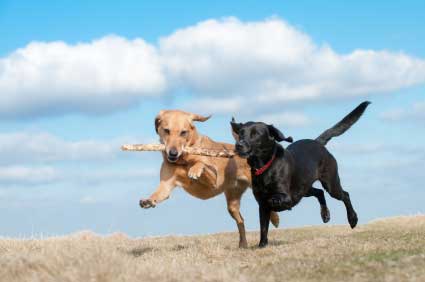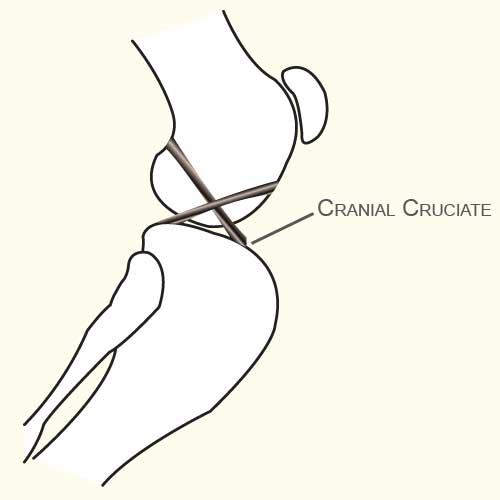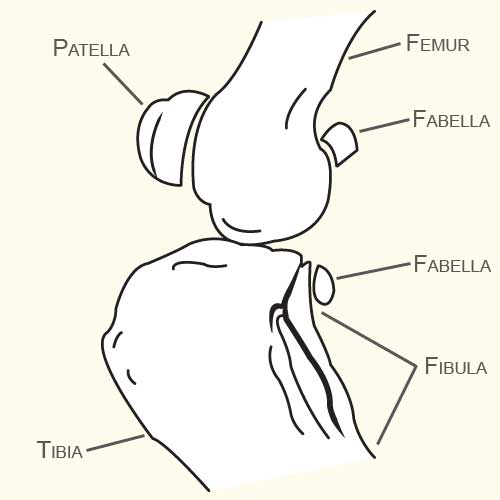Anterior Cruciate Ligament (ACL) Injury in Dogs

Anterior cruciate ligament (ACL) injury is a very common orthopedic problem in dogs. It is also known as cranial cruciate rupture. Sooner or later, most dog owners will encounter this issue. A torn cruciate can be a painful and debilitating injury for dogs and humans alike.
The Normal Dog Knee
A dog's knee is constructed much like a human knee. The knee is a complex joint composed of the femur (leg bone), tibia (shin bone), patella (kneecap) and several soft tissue structures that hold everything in place. These include the anterior and posterior cruciate ligaments, or cruciates. The cruciates are 2 fibrous bands inside the knee joint that cross like an X (see diagrams below). They keep the knee stable, especially during twisting or pivoting movements. The anterior cruciate ligament is the most injury-prone of the cruciates, as any athlete will tell you. A violent twist or clumsy landing can rupture (i.e., tear) the ACL. This causes pain and instability in the knee. The meniscus is a cartilage pad inside the joint that cushions the knee bones. When the ACL is torn, there is a 1 in 3 chance that the meniscus will be damaged as well.


Causes of Cruciate Ligament Rupture in Dogs
An ACL rupture typically occurs when a dog pivots or slips while running hard, causing a forcible twist or hyperextension of the knee. Contributing factors include age, genetics and obesity. Dogs of any age can tear their ACL, although it is more common as dogs age, or if they are carrying extra body weight. Certain breeds, such as Mastiffs, Newfoundlands, Akitas, St. Bernards, Rottweilers, Chesapeake Bay retrievers, and American Staffordshire terriers, are more prone to ACL injuries. A full ACL tear may start as a partial tear, which degrades the ligament over time, until one last misstep severs it completely.
Symptoms of ACL Rupture in Dogs
The most common symptom of ACL rupture in dogs is a sudden hind-limb lameness. The dog is reluctant or unable to bear weight on the injured leg. The leg is held up or just grazes the ground when the dog is walking or running. The knee may be noticeably swollen and tender to the touch. Over time, the lameness may improve somewhat, but will intermittently flare up.
Diagnosis of Cranial Cruciate Rupture in Dogs
The diagnosis of a ruptured ACL is made based on the above signs, by observing the dog's gait, and by palpating (feeling) the joint. Your veterinarian may notice swelling, pain, or a clicking sound in the knee. He or she will then perform the "cranial drawer" test. With your dog lying down, your veterinarian will grasp the end of the femur in one hand and the top of the tibia in the other. He or she will then attempt to create a back-and-forth sliding motion in the joint. If the tibia shifts abnormally forward like a drawer, the ACL is ruptured. A clicking noise can indicate that the meniscus is torn as well. Very muscular or tense dogs may need sedation so the veterinarian can properly perform this test. Your veterinarian may also order x-rays to be taken to rule out other problems such as a bone fracture, osteoarthritis or hip dysplasia.
Treatment of Cruciate Rupture in Dogs
If the ACL is completely torn, then surgery is recommended, especially in large dogs. Unfortunately, once a ligament is torn, it can never be re-attached. The objective of surgery is to stabilize the joint and create a new mechanism that takes the place of the ACL.
Three common surgical treatments are:
- Lateral Suture Technique (also called Lateral Imbrication). First, the knee joint is opened and cleared of any loose fragments. Then, a large, strong suture is passed from the fabella (see diagram, above), to a hole drilled in the front of the tibia. This tightens the joint and eliminates drawer movement, effectively doing the job of the ACL. The suture may eventually break once the dog's own scar tissue has stabilized the knee. Strict cage rest for a period of 8 weeks is essential after this surgery. Advantages of this procedure include its relative simplicity and lower cost. It is a good solution for smaller (<30lb) dogs but less optimal for large dogs due to a greater mechanical load on the knee. If the suture breaks prematurely, the surgical repair fails.
- Tibial Plateau Lateral Osteotomy (TPLO). As with the lateral suture technique, the knee joint is first opened and cleared of debris. Then the tibia is cut, rotated, and reattached in a different location using bone plates and screws. This changes the mechanics of the knee enough to stabilize the joint. An 8-week period of strict rest is necessary as the repair heals. The TPLO is currently the gold standard for treating ACL rupture in dogs and is recommended for large breed dogs (>50 lbs). Disadvantages include much greater difficulty of surgery and a higher cost. TPLO surgeries are generally only performed at specialty teaching hospitals or referral centers. The risk of infection is also an increased concern whenever bone plates and screws are involved.
- Tibial Tuberosity Advancement (TTA). This surgery is similar to the TPLO, in that the tibia is cut and then reattached at a different angle to mimic the mechanics of the normal knee joint. It is also a highly technical procedure that requires special equipment and is usually only performed at teaching hospitals or specialty centers.
To Operate or Not to Operate?
Surgical treatment of a fully ruptured ACL is highly preferable in most cases. Without surgery, degenerative joint disease inevitably sets in due to the chronic instability in the joint. Because the dog chronically favors the affected leg, more strain is placed on the healthy leg. Approximately one third of dogs will tear the ACL in the opposite leg within 1-2 years.
Non-Surgical Options for Treating Cruciate Rupture in Dogs
Although surgical treatment of a ruptured ACL is recommended for most dogs, there are some exceptions. If the animal is older, smaller (<30 lbs), has a medical condition that would make surgery unsafe, or if the cost of surgery is prohibitive, conservative management is plan B. Conservative management is the same as that for other forms of degenerative joint disease and includes:
- Restricted activity for 8-12 weeks
- Weight management
- Regular, low-impact exercise (leash walks, swimming, treadmill walking)
- Environmental management (install ramps, avoid stairs, etc.)
- Physical therapy (massage, aquatherapy, chiropractic, acupuncture)
Pain management is an important aspect of the treatment of both surgical and non-surgical ACL rupture. This may include non-steroidal anti-inflammatories (NSAIDs), newer pain killers such as tramadol and gabapentin, and disease modifying agents such as glucosamine and chondroitin. Your veterinarian can help design a care plan to help minimize your dog's discomfort and maintain a good quality of life.
Never give your dog any medication that was not specifically prescribed by your veterinarian.
You May Also Like These Articles:
Osteochondritis Dessicans of the Humeral Condyle (OCD)
Panosteitis in Dogs: Growing Pains
Medial Fragmented Coronoid Process
Disclaimer: This website is not intended to replace professional consultation, diagnosis, or treatment by a licensed veterinarian. If you require any veterinary related advice, contact your veterinarian promptly. Information at DogHealth.com is exclusively of a general reference nature. Do not disregard veterinary advice or delay treatment as a result of accessing information at this site. Just Answer is an external service not affiliated with DogHealth.com.
Notice: Ask-a-Vet is an affiliated service for those who wish to speak with a veterinary professional about their pet's specific condition. Initially, a bot will ask questions to determine the general nature of your concern. Then, you will be transferred to a human. There is a charge for the service if you choose to connect to a veterinarian. Ask-a-Vet is not manned by the staff or owners of DogHealth.com, and the advice given should not delay or replace a visit to your veterinarian.


